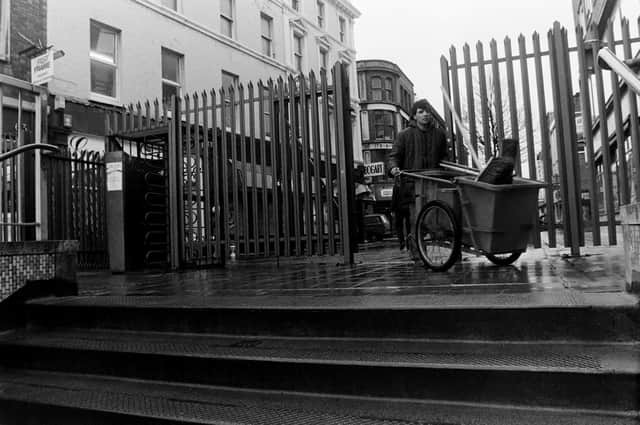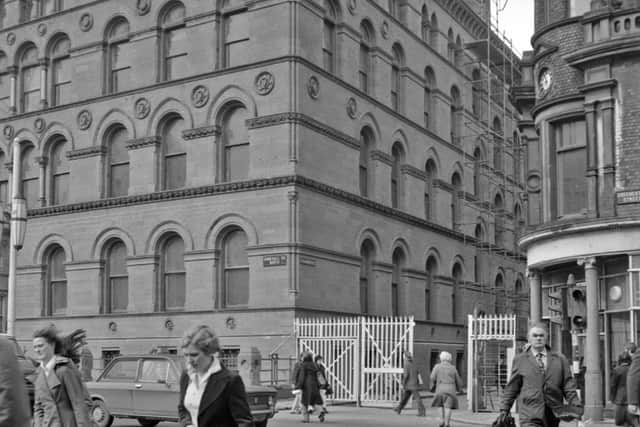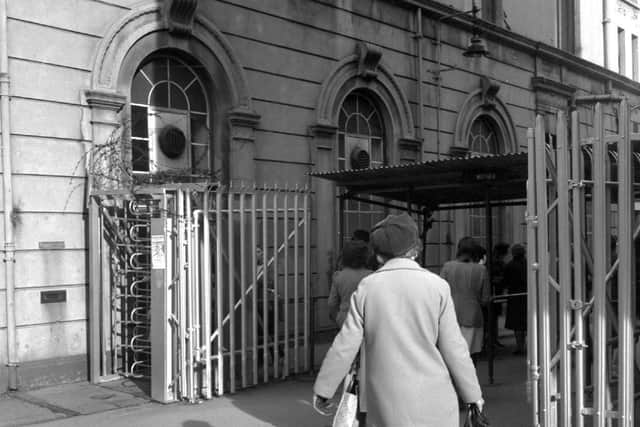Remembering the Ring of Steel that once surrounded Belfast city centre


No design drawings for the structure have survived and finding information on the ad hoc aesthetic constructed by the Army Corps of Engineers in stages over 1972 proved difficult for a team of researchers who are staging an event related to the security barriers.
Theatre company Kabosh, in collaboration with Professor Kate Catterall from the University of Texas, will present ‘Drawing the Ring of Steel’ this coming Thursday.
Advertisement
Hide AdAdvertisement
Hide AdTaking place at each of the Ring of Steel’s former main entrance and exit points into and out of the city centre – Donegall Place, Royal Avenue, Castle Street and High Street – this free 12-hour theatrical event aims to facilitate storytelling across communities and between generations.


James Bamford, a freelance consultant designing and producing maps, got involved in the project after hearing a talk from Kate about the security infrastructure that surrounded Belfast city centre during the Troubles.
He said: “I didn’t know much about this and was interested in finding out more.
“As part of the talk, Kate took us on a tour to see what remains of the ring. We got talking and she mentioned her project and how it would be great to have a mapping interface showing what was where, when.”
Advertisement
Hide AdAdvertisement
Hide AdHe continued: “I think that the Ring of Steel is a really interesting phenomenon, not just in what it represented at the time, but also in how it disappeared and is remembered by those who were there.


“From a built heritage and urban geography perspective, it’s quite a unique thing that although quite recent, belongs to a totally different time.”
He added: “I spent a lot of time making phone calls and submitting FOI requests – to organisations like PSNI, MOD, NI Office, Belfast City Council, academics, local historical organisations – and had no joy at all. It was like a barrier came up, ironically, and this was still a complicated topic that none of the authorities were prepared to discuss.
“The only lead I did manage to come across in my many attempts to get info from local authorities in Belfast was Robert Heslip - Tourism, Culture, Heritage and Arts Officer with Belfast City Council.
Advertisement
Hide AdAdvertisement
Hide Ad“Robert was very helpful and pointed me towards the National Archives where I did find most of what I needed.
“I felt like I’d stuck gold when I walked into the reading room and the files I’d ordered were piled high on the table.
“I used the British Newspaper Archive to find relevant press articles and I also managed to source some great material from local photographers who were active at the time.
“I spent time walking around the city centre getting a feel for how it was all organised and spotting the slight remnants that still exist – holes in walls, shreds of wire, bollards that have replaced gates, etc.
Advertisement
Hide AdAdvertisement
Hide Ad“This gave me some insight into how Belfast city centre is still somehow affected by the ring, how it sort of echoes still today in the subtle divisions between what was outside, and what was within.”
Professor Kate Catterall was born and raised in Belfast and has direct personal experience of the Ring of Steel.
She said: “For over 20 years during the conflict, the series of gates, fences, turnstiles, search stations and blocked roads known as the Ring of Steel became an increasingly prominent feature of the urban environment in Belfast.
“Staffed by both civilian searchers and armed security personnel, the cordon had a significant impact on the daily lives of all who passed in and out of the city centre every day, to work, shop or socialise.
Advertisement
Hide AdAdvertisement
Hide Ad“Ongoing development since the 1998 Peace Agreement has erased much of the evidence of the ‘Ring of Steel’, and only traces remain today to show that it ever existed. This work aims to create a record of what was a singular and largely unrecorded episode in Belfast’s recent history.”
Mapper James added: “I do know from talking to Kate that she has put so much work into making [this event] happen and that she is hoping to capture memories from people and create a sort of archive of what life was like then.
“I imagine it might bring out some expressions of feeling for this difficult period, and maybe serve as a kind of cathartic experience for the city and people who remember it.”
On Thursday, at each of the four ‘Drawing the Ring of Steel’ sites, performers will redraw the lines of the security checkpoints and barriers and enact choreographed search motions.
Advertisement
Hide AdAdvertisement
Hide AdOther performers in 1970s dress will interact with the public asking them questions about their memories or knowledge of the ‘Ring of Steel’ and collecting their stories.
Stories which are recorded from audience members on the day of the piece will be transcribed, reviewed, anonymised and featured on the project website ringofsteel-belfast.com.
Paula McFetridge, Artistic Director of Kabosh, said: “This event aims to highlight how far Belfast’s city centre has developed from those times, into an inclusive shared space.”
——— ———
A message from the Editor:
Thank you for reading this story on our website. While I have your attention, I also have an important request to make of you.
Advertisement
Hide AdAdvertisement
Hide AdWith the coronavirus lockdown having a major impact on many of our advertisers — and consequently the revenue we receive — we are more reliant than ever on you taking out a digital subscription.
Subscribe to newsletter.co.uk and enjoy unlimited access to the best Northern Ireland and UK news and information online and on our app. With a digital subscription, you can read more than 5 articles, see fewer ads, enjoy faster load times, and get access to exclusive newsletters and content. Visit https://www.newsletter.co.uk/subscriptions now to sign up.
Our journalism costs money and we rely on advertising, print and digital revenues to help to support them. By supporting us, we are able to support you in providing trusted, fact-checked content for this website.
Ben Lowry
Editor